 |
|
 |
| |
Note:
The ads that you see here are not controlled, sponsored
or endorsed by Covington Innovations.
They are brought to you by Google
and will vary depending on your personal browsing history. |
| |
|
2013
October
30-31
|
Sunspots
|
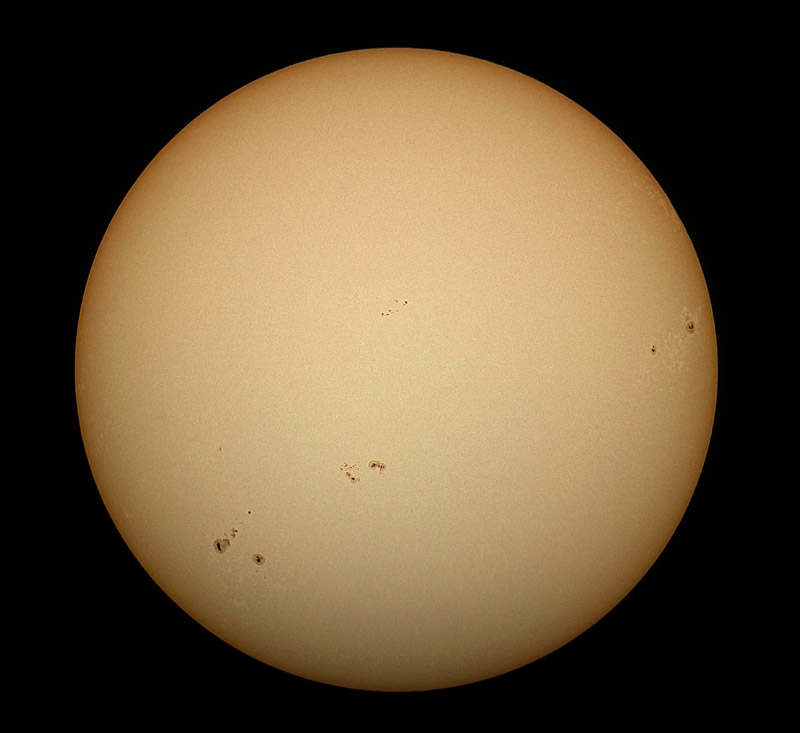
|
| |
Yes, we have sunspots... this particular solar maximum is proceeding irregularly, but there
are plenty at the moment. This is a stack of four 1/2000-second exposures with my Celestron 5
and Canon 60Da, processed with RegiStax. I used a Baader solar filter that has seen better
days — there is actually a hole in it, patched with tape — and have just ordered
a new Thousand Oaks filter. (I had one back in May 2012 but it was the wrong size for my telescope.)
Incidentally, I am such a coward about solar observing that, these days,
even though I know the filter is perfectly safe, I never put my eye to the
eyepiece, relying entirely on the camera's video screen instead.
Permanent link to this entry


|
2013
October
29
|
Clearer thinking about character sets and Unicode
Here are some further thoughts about the Unicode question. I've been trying to plot
strategy for several natural language processing projects, and I finally realized that
before choosing a file encoding, I needed to make some decisions about character sets.
Unlike the file encodings, the character sets form a neat hierarchy, each one
subsuming the previous one. Specifically:
- ASCII has the minimum for encoding typewritten English.
- ISO Latin-1 (ISO-8859-1) adds the accented letters needed for major western
languages. Each accented letter has a unique code.
- Windows-1252 adds curved quotation marks, dashes, and a few other specialized
characters. Reportedly, most implementations of Latin-1 nowadays are actually
Windows-1252.
- 16-bit Unicode (that is, Unicode without code points above FFFF) adds a vast
array of characters for all the languages of the world, including many
non-western writing systems. Each character fits in a 16-bit char type
in modern programming languages. However, some characters can be written more
than one way (the combining diacritic problem) and some characters simply occur
more than once due to overlapping character sets that were combined to make Unicode.
- Full Unicode includes some really exotic characters that do not fit in a single
16-bit char.
Now here are my thoughts:
Natural language processing software needs to control its character set so that
recognition of words will be easy and reliable.
The input to our software should be able to use any popular encoding,
with UTF-8 as probably the preferred one.
Upon input, as a minimum, Unicode should be normalized so that each character
is always written the same way.
In fact my inclination is to impose heavier limitations, even possibly
reducing all characters to ASCII after tokenization. (Accents are often left out
of headlines, and relying on them would lead to mistakes. Dashes can be tokenized
as multiple hyphens, as on a typewriter. My inclination is not to use non-Latin
alphabets or writing systems internally, to avoid putting an obstacle in the way
of colleagues who don't know an exotic language. That is, if a non-Latin alphabet
is involved, the tokenizer should transliterate.)
The output of the software might well be pure ASCII, or, for legibility,
Windows-1252 or UTF-8, user-selectable. It should be confined to the Windows-1252
character set at the most.
Permanent link to this entry


|
2013
October
26-28
|
Unicode or not Unicode?
[Extensively revised.]
I've been matching wits with Unicode
the past couple of days, getting ready for some projects
that involve foreign languages, and have been a bit vexed by it all.
ASCII is a thing of the past. Even the English language requires non-ASCII characters,
such as curved opening and closing quotation marks. Languages like Spanish certainly
require non-ASCII characters.
ISO Latin-1 (ISO-8859-1), which is essentially the same as Windows "ANSI" (Windows-1252), has
some advantages. Every character is one byte. The characters commonly needed for
English, Spanish, French, and German are all there. Every character is written
only one way (we do not have the Unicode "combining diacritic" problem).
But ISO Latin-1 doesn't have all the characters of all the languages of the world.
There are several ways of encoding Unicode, but UTF-8 is the only serious contender,
in my view. So it boils down to Latin-1 versus UTF-8.
Until just now, I was gung-ho to use UTF-8 for everything, and to include the
byte order mark on every UTF-8 file.
Then I started looking at how various pieces of software respond to various kinds
of text files. Major pieces of Windows software, including Notepad and Excel,
prefers Windows-1252 but will automatically accept UTF-8 if there is a byte order mark.
R, on the other hand, takes either Latin-1, or UTF-8 without a byte order mark.
This is the case under both Windows and Linux.
In fact, Latin-1 a.k.a. Windows-1252 is better supported in Linux and on the Macintosh
than I thought. It seems to be the character set that won't die...
So my considered opinion, now, is that UTF-8 is best but Latin-1 is tolerable.
I also think we should consider using the extension .utf8 instead of .txt
for files that are known to be Unicode.
Whether to include the byte order mark, I don't know. If it's there, many pieces of
software (including the input libraries of C#) will automatically recognize the file
as UTF-8 and will automatically skip the byte order mark. But R reads it and keeps the
byte order mark as if it were a character. Can't win.
Permanent link to this entry


|
2013
October
25
|
Why older adults are especially vulnerable on the Internet (II)
Back in July I wrote about
why mature adults are especially vulnerable to
scams, viruses, malware, and blunders on the Internet.
If you haven't read it, click through and do so.
Then come back to here...
I've noticed a few more factors at work.
One of them is that older adults often underestimate the
size of the Internet and think only a few like-minded people
will ever communicate with them, even indirectly. Sometimes they even think
anything they receive must come from a close associate.
Not at all! The Internet puts you in touch with the wide world,
and it's very wide indeed.
I call this the "small-circle-of-friends illusion" and it affects
newcomers to the Internet of all ages, but I've seen older people
stick with it when they should have known better.
This illusion often makes mature adults far too willing to trust,
and pass along, a message that came from nobody-knows-where,
nobody-knows-when. Maybe someone lost a puppy and asked all the
friends of their friends to spread the word. But for all you know,
the puppy was lost 3 years ago, 2000 miles away, and was found a week
later. Just because it came to you from your best friend
doesn't mean it originated in your small circle!
Bottom line: "Pass this on" is not the right way to spread information
on the Internet. It's like mailing someone a letter and asking him
to make copies by hand and mail them to all of his friends, when what
you really needed was to put something in the newspaper. The Internet's
equivalent of the newspaper is the World Wide Web, and anybody can
write on it. "Pass it on" e-mails are not the right way to spread news.
Yes, you feel like you're helping, but the feeling is an illusion;
either you're doing no good, or you're being manipulated.
A second vulnerability is that some, not all, older adults are
unwilling to admit that they don't know enough. They take a guess
about something important, and are satisfied with it, and soon forget
that it's only a guess.
These are typically people who haven't been in a new environment for
a long time and are simply not open to learning. If you're not open
to learning, in the world of personal computing you're sunk!
The rest of us often laugh at people who won't admit to others (or even
to themselves) that they've taken a wild guess.
Think of the people who mistake DVD drives for coffee cup
holders. You might guess it's a coffee cup holder, but do you
know? Of course not. You have to remember the distinction
between what you've guessed and what you know from reliable sources.
Even worse things can happen. By now, one of the clichés of the
Internet is the older adult (typically a parent or grandparent) who copies
younger people's fashionable language (or so they think) without knowing
what it means. All of a sudden Grandma is using abbreviations for dirty
words, and she doesn't know it!
Permanent link to this entry


|
2013
October
24
|
Extreme fixed-tripod astrophotography: Cygnus
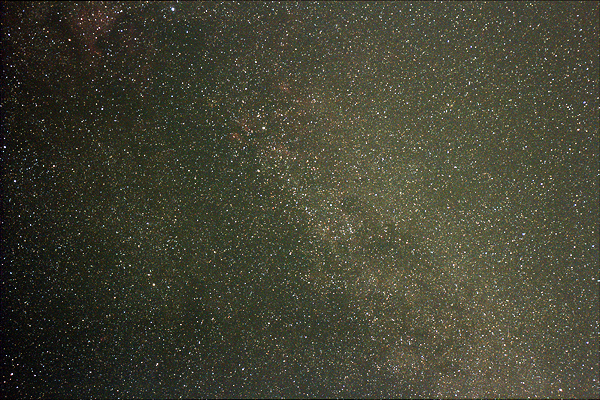
This is a hasty experiment to see if the Milky Way can be photographed with
only the equipment that a serious non-astronomical photographer would have.
I'm trying to come up with a technique that a friend will be able to use
on a trip to Africa next spring.
This is the middle of Cygnus, photographed with a Canon 60Da on a fixed
tripod and a 50-mm f/1.8 lens at f/2.8. This is a stack of sixteen
3.2-second exposures at ISO 6400, combined with DeepSkyStacker.
Long exposure noise reduction was done in the camera, and no flat-fielding
was done (although it certainly could be).
As you can see, it was a success. You can even see a good bit of nebulosity,
although a camera with conventional spectral response (rather than a 60Da)
might not pick it up.
Permanent link to this entry


|
2013
October
23
|
Photoshop reports "not enough memory" opening DeepSkyStacker output
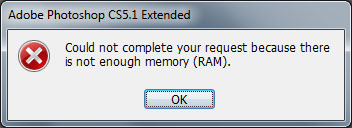
"Could not complete your request because
there is not enough memory (RAM)."
The autosave.tif file produced by DeepSkyStacker is in 32-bit rational-number TIFF format.
Photoshop (version 5.1, suite 5.5) can open this if you're using the 64-bit version of Photoshop,
but not the 32-bit version. (Adobe supplies them together, but the 64-bit version of Photoshop
installs and runs only if you are using a 64-bit version of Windows.) If you try to open this type of file
with 32-bit Photoshop, you get the misleading error message shown.
(I have no idea whether 32-bit Photoshop does not support that type of TIFF file
or whether there is perhaps something subtly wrong with the format of the file itself
as created by DeepSkyStacker. I have heard reports of other software that also will not
open these files. It is significant that the Photoshop error message is misleading,
suggesting that the file is malformed in some subtle way. If Photoshop failed to
recognize the file as a supported format, it should say so.)
One workaround is to save your file from DeepSkyStacker as 16-bit TIFF, preferably after doing
some adjustment of levels and curves.
My experience is that PixInsight has no trouble opening these files. I am using the 64-bit version
and have not tested the 32-bit version.
I want to thank Brian Johnson for asking this question on the DeepSkyStacker mailing list,
and Dan Crowson for pointing out the answer.
The government is running again, I have a new consulting project, and I'm about to stop
having quite so much time for astronomy. Stay tuned for a much wider range of topics
in the Daily Notebook, and perhaps a bit less material per day.
Permanent link to this entry


|
2013
October
22
|
Note on making a red LED penlight for astronomy
I've made myself a red LED penlight to use while doing astronomy, red so that
it doesn't spoil my night vision. I don't have time to write up a complete
"how-to," nor do I consider it quite perfected, but here's how I proceeded.
(1) Get a penlight of the kind doctors use, such as
this one.
Important attributes: Replaceable batteries and bulb; old-style penlight bulb (not LED);
bulb is somewhat recessed so the bright light is not visible from the side (important
for astronomy).
(2) Also needed: A bulb with the same kind of threads on its base, but preferably
with a round globe; a red LED; a 100-ohm resistor.
(3) Soak the bulb in acetone or maybe lighter fluid to dissolve the cement
that holds the globe to the brass base. Pull the globe free, unsolder it
from the base (after the flammable solvent has evaporated!), and clean out
the base.
(4) Carefully reassemble the LED and resistor into the bulb base. After soldering,
I used plenty of glue and also ended up using part of a small rubber
grommet to keep the LED centered and to give it a "shoulder" so it wouldn't
protrude too far.
(5) Reassemble the penlight and try it out.
I've done 2 variations on this project over the years, and neither one came
out quite perfect enough to publish, although both are serviceable.
I may work it up into a construction project article later.
Permanent link to this entry


|
2013
October
21
|
Canon 40D and 60Da spectral response compared
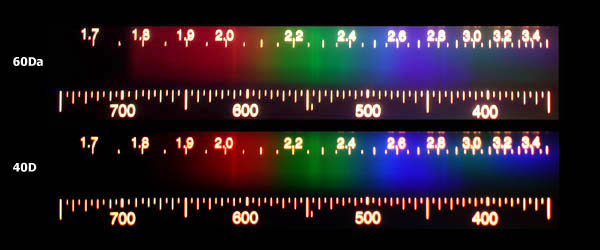
The Canon 60Da is a special astronomy DSLR with extended sensitivity to
the red part of the spectrum (especially 656 nm, the wavelength at which
most hydrogen nebulae shine). The 40D is a conventional DSLR.
Here is a comparison of what they see, looking into a
Project STAR spectrometer.
The light source is a white piece of paper illuminated by a halogen
incandescent lamp; there were also fluorescent lights on in the room,
and you can see some of their bright emission lines, as confirmation
that the wavelength scale is correct.
You can see that the 60Da has useful response out to 690 nm;
the 40D, like all normal digital cameras, stops around 640 nm
to better simulate human color vision.
Important: The blue and greenish light to the right of 450 nm
is an instrumental artifact from another order of the diffraction spectrum.
I took these pictures quickly so I could include Ektachrome film
in the comparison. The Ektachrome hasn't been developed yet, of course,
and if I didn't get a successful picture, it will be too late, since
it's my very last roll of Ektachrome. But I hope to publish a
version of this picture that includes Ektachrome before too long.
Permanent link to this entry


|
2013
October
20
|
Veil Nebula (Cirrus Nebula)
|

|
| |
Here's the last of my pictures from Deerlick on October 5. Same technique as all the recent
ones, but this is a stack of 17 (yes, 17) 30-second exposures.
You're looking at a rich field in Cygnus with the Veil Nebula (a supernova remnant)
at the lower left — a C-shaped portion is the most conspicuous part.
The star cluster NGC 6940 is at the lower right, and there is a patch of
dark nebula above the center.
Now I must either take more pictures or find something else to blog about!
Permanent link to this entry


|
2013
October
19
|
Andromeda Galaxy
|
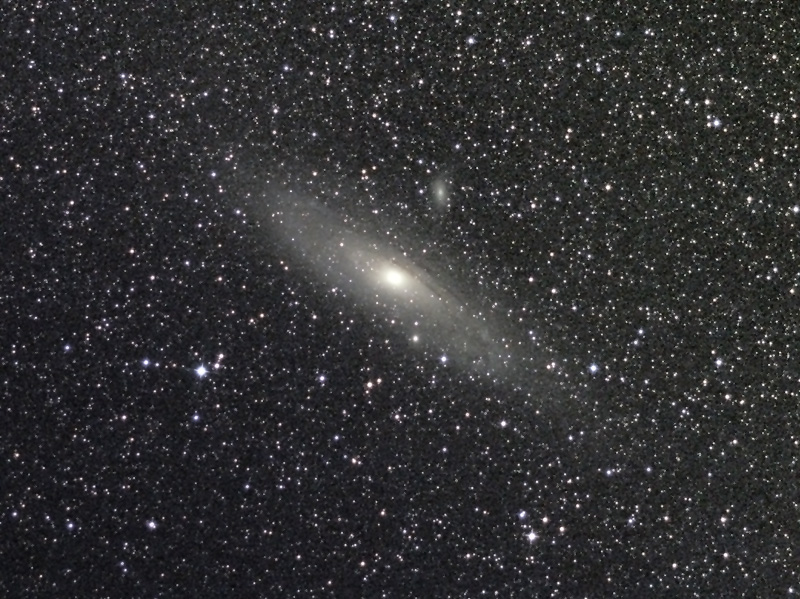
|
| |
This isn't my best-ever picture of M31, but it's notable for
the seemingly inadequate equipment with which it was taken: a 105-mm f/2.8 lens and Canon 60Da camera
body on an iOptron SkyTracker. This is a stack of eleven
30-second exposures at ISO 3200. You're looking at an enlarged
area from the middle of the picture.
Permanent link to this entry


|
2013
October
18
|
Nebulae and star clouds around M7
|
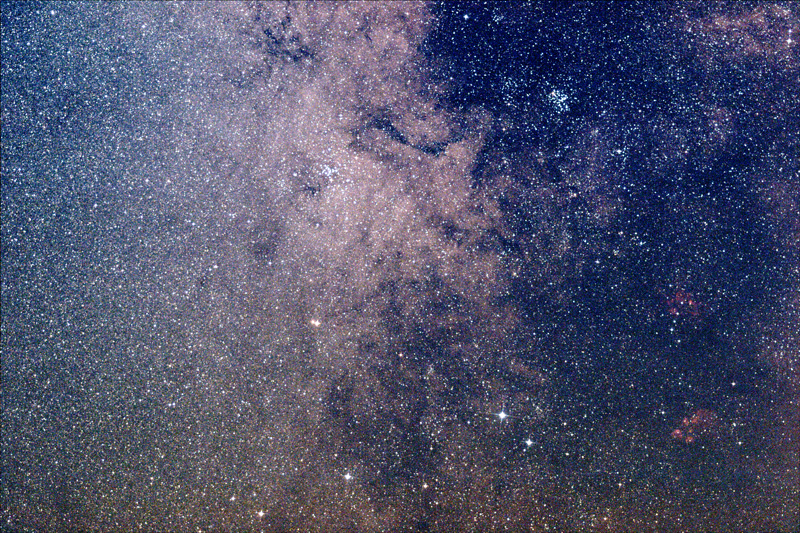
|
| |
This rich star field, with star clouds and dark dust clouds,
includes the star cluster M7 (Ptolemy's Cluster, above center)
and even some emission nebulae, including the Cat's Paw Nebula
at lower right.
Same technique and equipment as the previous picture (below),
but only 8 exposures were stacked.
Permanent link to this entry


|
2013
October
17
|
Bright and dark nebulae around Gamma Cygni
|
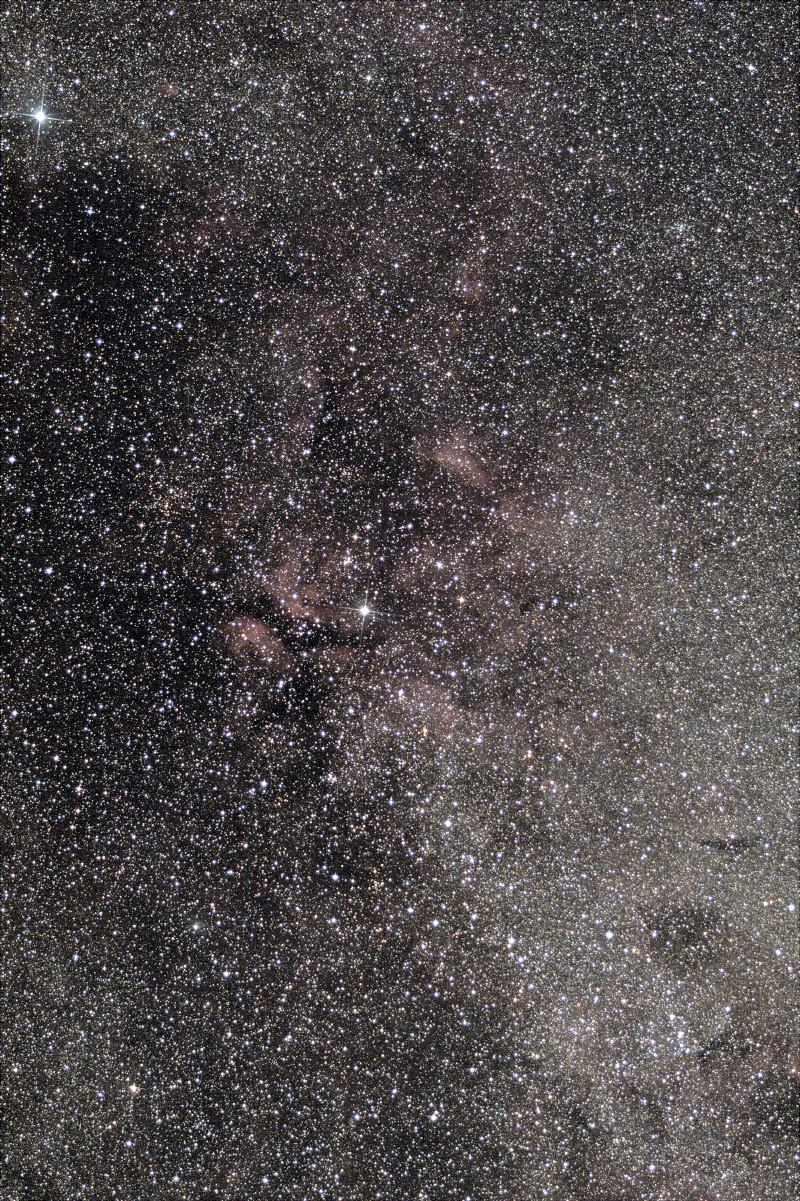
|
| |
This rich star field, with red hydrogen nebulae and dark dust clouds in front of clouds
of distant stars, is in the middle of the constellation Cygnus.
I photographed it from Deerlick on October 5.
Stack of fifteen 30-second exposures at ISO 3200 with a Canon 60Da and
Sigma 105/2.8 lens, wide open, on an iOptron Skytracker.
Permanent link to this entry


|
2013
October
16
|
Using Stellarium for locations other than your own
Today I was trying to use Stellarium to compute
the appearance of the sky in Zambia, to help a friend prepare for a trip.
Everything looked right except that the times were a few hours off — the sun
seemed to be setting at noon, or something like that.
I figured out what was going on: something that was logical but produced
surprising results. Stellarium asks your operating system (Windows, MacOS, or Linux)
for the true time of day and your time zone. So it was correctly showing me
the sun setting in Zambia at noon Eastern Daylight Time, which was,
I think, 6 p.m. there.
There are several workarounds, but the simplest is to set Windows itself to your
intended location when you want to use Stellarium to predict the sky somewhere else.
Then the computer's clock will show the time zone of the place you're trying
to calculate.
I said "everything looked right." Yes, I did calculate the Zambian sky
roughly in my head before asking the computer. I do things like that... I learned
about the sky back when we didn't have computers to do our figuring for us.
The knowledge has served me well. Practically every time I've looked at the
night sky since 1970 or so, I've known what I was looking at. I was only
flummoxed once, during a transpacific flight in 1973, when I had been asleep
and woke up not knowing whether I was in the Northern or Southern Hemisphere
and also not knowing whether I was in the Eastern or Western Hemisphere.
I then failed to recognize Fomalhaut.
Permanent link to this entry
Recommendations...
Martin Mobberley's entertaining,
informal biography of Sir Patrick Moore has been an enjoyable
trip down memory lane.
One of my greatest regrets is that I never met Moore;
I've only been to one B.A.A. meeting (maybe two?) and he wasn't there.
But the height of his career coincided with my entry into amateur
astronomy, and also Martin Mobberley's, so the book called forth a host
of memories.
I am about to try out PixInsight
image processing software.
It comes from Spain, and one thing that encourages me is that I see plenty of
excellent English and also excellent Spanish on its web site.
Far too many bilingual endeavors end up mangling one of the two languages,
or at least peppering it with errors.
These people looks like perfectionists — exactly what we want.
Permanent link to this entry
OK, government...
We will not soon forget the damage done by our Congress, which has just
now agreed to pay its bills and reopen the federal government.
Even the threat or needless risk of defaulting on federal debts
damages our economy and makes us look silly.
Well-governed countries do not do such things.
Everything I said two weeks ago still stands.
I plan to vote against every incumbent in the next election for
their offices, whether 2014 or 2016. (This can be done at the primary
level, to avoid changing parties.) There is plenty of blame to go
around; both sides were unreasonable; both sides are guilty of
legislative malpractice.
Permanent link to this entry


|
2013
October
15
|
Dark nebulae near Delta Aquilae
|
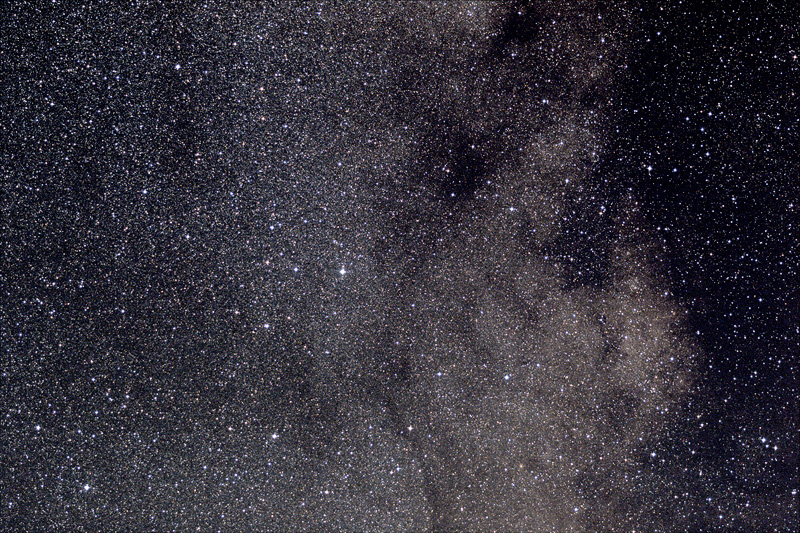
|
| |
I made a second trip to Deerlick on October 5, and conditions were not quite
as good as October 1.
Here's one of the pictures from the second trip, a stack of nine 30-second
exposures with a 105-mm lens at f/2.8, Canon 60Da camera body, and iOptron SkyTracker,
at Deerlick, processed in the same way as pictures posted earlier this month.
You're looking at the middle of the constellation Aquila.
This flurry of astronomical activity is brought to you by the
federal government shutdown. As soon as Congress resumes doing its
job, I'll be busier!
Permanent link to this entry


|
2013
October
14
(Extra)
|
Putting your own horizon line into Stellarium
I am wholeheartedly recommending Stellarium
sky charting software. This is a brief note on how to put your own measured
horizon line into it.
The Stellarium people give you plenty of instructions
(here,
here,
and here) about how to
create your own picture of the earthly landscape to
display under the stars in Stellarium. You can even do this
by taking a panoramic photograph, then transforming it into
a 1024×2048-pixel PNG file with the sky marked as transparent.
What I want to address is something much simpler.
You may have measured the altitude and azimuth of points along the obstructed
horizon around your telescope site, as I have.
A file containing these data in numerical form is useful with TheSky
and Skychart, among others.
How can we use it with Stellarium?
Here's what I did. First I plotted the data as a line graph using R,
taking care to use the same scale for the horizontal and vertical axes
and to have 0 (altitude) in the middle of the graph:
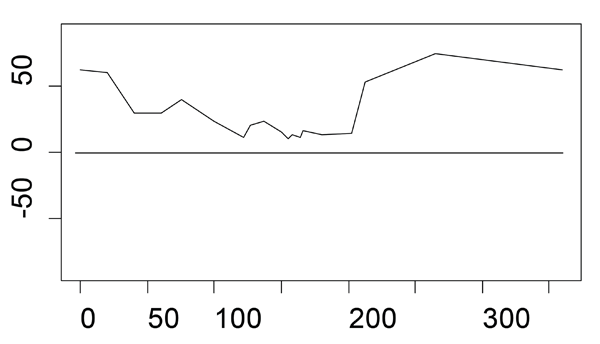
I converted this to a high-resolution bitmap, cropped it at the left
and right ends of the zigzag line, and, without changing the shape,
converted it into a 1024×2048-pixel PNG file in which the line
was yellow and everything else was transparent. Here's how it looked
in Photoshop:
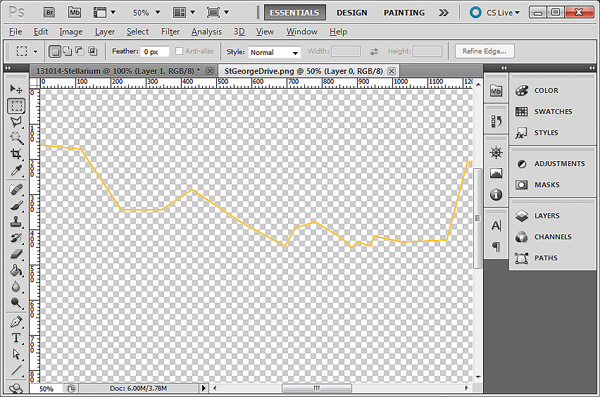
Because this is a short note, I can't go into the details of how to do
this, but there are plenty of tutorials on how to create transparent
areas in PNGs. Essentially you select just the line using the magic wand
tool, paste it onto a transparent layer, and then delete any layers
that are not transparent.
Finally I created a landscape.ini file per Stellarium's instructions,
making sure to include the lines
type = spherical
angle_rotatez = -90
because for some reason Stellarium expects panoramas to start in the east
rather than the north.
Here's the result:

The "ground" is transparent and is in fact just a jagged line through the sky
showing the approximate limits of my vision past trees and houses.
Permanent link to this entry


|
2013
October
14
|
"Feature transfer error" when installing software
Some Administrator accounts can't install software
Error: -2 The system cannot find the file specified
I've finally exorcised a ghost that was haunting my desktop Windows 7 system.
The symptom was this strange-looking error whenever I tried to install certain
pieces of software — notably MaxIm DL and Cisco AnyConnect.
The workaround was to log on a different Administrator account, and then
the installation went just fine. Only one account was haunted, and I was
almost ready to delete the account.
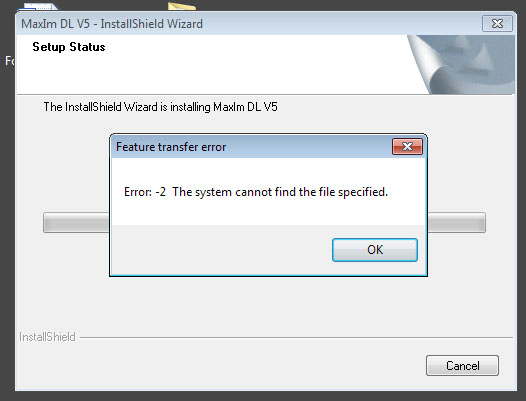
This afternoon the error plagued me again as I tried to update MaxIm DL,
and I tracked it down and fixed it.
It has to do with permissions on C:\Users\username\AppData\Local\Downloaded Installations.
Normally, System, Administrators, and the individual user all have full control.
In my "haunted" account, though, only the user (owner) had full control; the other
permissions weren't inherited. I think this may have happened when I copied some AppData folders
from an older version of the account.
This matters because InstallShield runs as the individual user but the .msi installer
runs as System. Thus, the files unpack successfully and then InstallShield hands them
off to MSIEXEC, which can't see them.
Nor does MSIEXEC tell you what it's looking for. I had to use Process Explorer to find out.
To fix the problem, right-click on
C:\Users\username\AppData\Local\Downloaded Installations,
and choose Properties, Security, Advanced, Change Permissions.
Remove the explicit permission for the individual user,
and check "Include inheritable permissions."
Then click "Apply," make sure three permissions are showing up, and click "OK."
I found several other folders in AppData with the same peculiarity and fixed them
the same way, just in case it matters.
Permanent link to this entry


|
2013
October
13
|
The North America Nebula
|
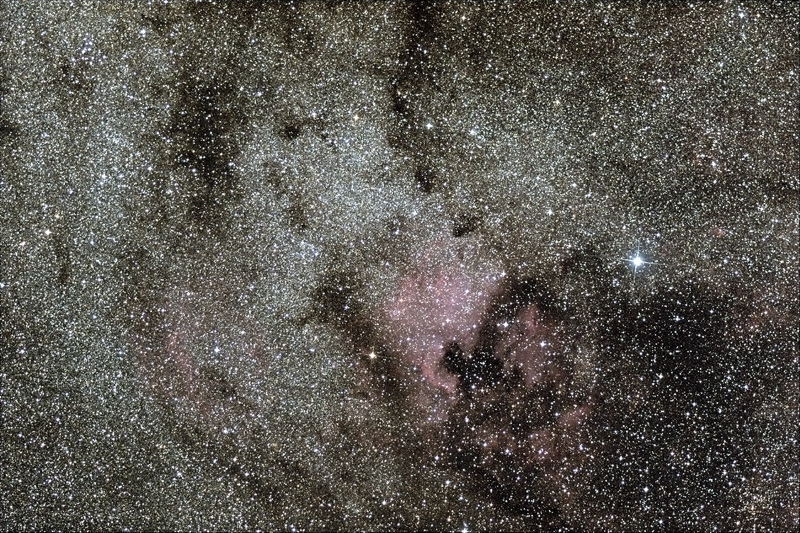
|
| |
Musicians have theme songs — favorite songs that they sing or play
as a sort of personal trademark — and I have the North America Nebula.
I never tire of photographing it with different kinds of equipment under
different conditions. Here's what I got on October 1, a stack of 10 30-second
exposures with a 105-mm lens at f/2.8, Canon 60Da camera body, and iOptron SkyTracker,
at Deerlick, processed in the same way as pictures posted earlier this month.
Permanent link to this entry
The richness of our galaxy
|

|
| |
Here is a very rich field of stars, clusters, and nebulae in roughly (not exactly) the direction of
the center of our galaxy. Equipment and technique exactly the same as for the
North America Nebula (above). Sagittarius was low, close to the horizon, and
you may be able to see some man-made skyglow toward the bottom of the picture.
Objects of interest here include the Lagoon and Trifid Nebulae at the
lower right, the Swan Nebula at the upper left, and the star cloud M24
above center.
Permanent link to this entry


|
2013
October
11-12
|
Reprocessed...
OK, all the astrophotos on this page (for October) have been
reprocessed with better flat-field correction, and you should
scroll down to see them. I'll start releasing more photographs
in the coming days, and I'm also going to reprocess some pictures
on the September page. [This has been done.]
The problem was that "set black level to 0" in DeepSkyStacker was
checked and should have been unchecked. As a result, the flat-field
correction was not quite right; there was a difference in color and
contrast between the center of the picture and the edges.
Also, the flat-field images that I was using for correction
were underexposed.
For the uninitiated: Almost all camera lenses produce a picture
that is slightly darker at the edges than at the center.
This is not necessarily a defect; it is also a consequence of
geometry (the cosine-4 law). But in astronomy, we increase the
contrast so much that this needs correcting. The tactic is to take
pictures of a blank white surface using the same lens, then perform
some computation. The computation was being done incorrectly,
and now I've corrected it.
Scroll down, and enjoy!
Permanent link to this entry


|
2013
October
10
|
How much does it cost to get a book published?
I just heard a radio commentator advising a young woman who was thinking
of borrowing lots of money to pay to have her first book published.
Fortunately, he steered her clear of it. But it got me thinking about
how little most people know about the publishing industry.
As a book author, I fairly often get asked two questions that strike
me as strange. One is, "How much did it cost you to get your book published?"
The other is, "How many millions have you made from your books?"
The answer to the first question is that I have never paid a cent
to a book publisher. Never have, never will. The way it works
is that the publisher takes all the financial risks, bears all
the production expenses, edits, typesets,
prints and sells the books, and pays
me royalties.
(That, by the way, is why you can't buy my books from me.
I don't manufacture or sell them myself.)
The answer to the second is that the income from my books is
measured in thousands (or even hundreds), not millions.
Not every book is a best-seller. Tens of thousands of good
books are published every year, and only a handful make millions.
Writing is not the way to get rich.
And that's a problem with some starstruck aspiring writers.
Even if you're very, very good, the odds are that you will never
be one of the top ten people in the world in your field.
The world is big, and ten is a small number.
I would go further and say that the words "I want to be a writer"
are a bad sign. "I want to write about X" is much, much better.
Getting back to how books are published: Yes, I know about self-publishing.
In fact, it is easier than ever to publish your own book through Amazon,
Barnes and Noble, or other companies. They have an efficient distribution
network, which is what self-publishing "vanity presses" lacked in the past.
Self-publication doesn't cost much, provided you
can provide a well-edited book (perfectly spelled and punctuated, with page numbers,
neat layout that follows standard requirements). If you can't do that,
you'll have to pay someone to edit the book for you — and in fact
I recommend bringing in an editor, because they will catch things you
didn't, but you shouldn't give them garbage to work with. If you cannot word
your sentences clearly, spell correctly, and punctuate correctly,
then in my opinion you
are not a writer. You need a writer. You are like an "artist" who
wants someone else to touch up the paintings.
Self-publishing is a great way to go if (1) you can afford the (small) cost,
and (2) you have something that you know will sell 50 copies, and you want to
make it available to the wider public, and (3) you have ways of publicizing it
by word of mouth (especially through online friends and web sites that are
interested in the subject — but please don't become a spammer).
Don't expect to make money that way. Right now I'm looking at a self-published
book (not my own) on Amazon that has apparently not sold any copies at all for several weeks.
It's fiction, of course. And here's a related point: Most fiction writers are not as good
as they think they are. The fact that you enjoy it doesn't mean
anyone else will enjoy it. If you write non-fiction, as I do, it's easier to get
feedback from people who will tell you whether the book is interesting and useful.
Fiction is a wild stab into the unknown. Even some of the best authors have
been rejected by some publishers and critics.
Of course, you can make money self-publishing. If you have a highly
salable book, you can make more money than by going through an existing publisher.
Why? Because you're doing two jobs and running two businesses,
author and publisher. Being a publisher can be a lot of work!
It's a business I chose not to go into. I have plenty to do already.
The case against self-publishing is that you don't get an established
publisher's prestige. When my books are published by Cambridge University Press,
the public has some assurance that they've been reviewed and accepted by
competent people. If I published them myself, you'd have no assurance
that I'm not a crackpot.
Thanks to new technology, the cost of printing books is plummeting,
and that cuts both ways. Not only does it make self-publishing easier,
it also opens up new opportunities for commercial publishers.
The other day a major scientific
publisher came by and basically wanted to publish any research I want to share,
including working papers (reports of work in progress). This would be a deal
that pays me no royalties but makes the work available quickly to the entire
world, each copy printed on demand.
It's much better than just putting my research on my own web page, which might
vanish if I moved away from UGA.
I can think of several scientists who would like to publish some of their work
that way, although none of mine quite fits. (The publisher, by the way, was
not Cambridge. Think Germany, and mathematics, and horse-heads...)
The bottom line? "If you're a writer, why aren't you rich?" Because almost
no writers are rich. Like most work, writing pays just well enough to get
people to do it. In fact, at the moment I'm not writing books because I can
earn more money doing other things. That, of course, can change from year to
year as opportunities come along.
Permanent link to this entry
Those reprocessed astrophotos are coming. Stand by!


|
2013
October
9
|
Stand by for reprocessing
It has come to my attention that the flat-field corrections applied
to my last several astrophotos have not been entirely correct.
I'm going to reprocess all the photographs I've published for the past
couple of months before releasing more. Stand by and be patient...
Permanent link to this entry
Astronomy software
I've long been a user of both TheSky and Starry Night astronomy
software, both of which are commercial packages. Recently I started looking for comparable
software that might be available free, so I could install it without restriction
on multiple computers.
I've tried out Skychart (Cartes du Ciel), which looks very
good. Interestingly, Skychart is built with the Lazarus compiler, an
open-source multi-platform compiler that keeps alive the Borland Delphi
language, the first Windows programming platform I ever really liked.
I also hear good things about Stellarium, which
I haven't tried yet. Stay tuned...
Addendum: Both are good, and the price is right — both are free!
Stellarium has a more sophisticated user interface, but both do their jobs reliably.
I am putting both of them on all my computers. The configuration is easy to port
from one computer to another; it's in
Application Data\Local\Skychart and
Application Data\Roaming\Stellarium respectively.
Permanent link to this entry


|
2013
October
8
|
Dark nebulae in Scutum
|

|
| |
[Reprocessed 2013 October 12.]
Here you see a rich region of star clouds and dark nebulae in Scutum, with the cluster
M11 at the bottom (looking like a fuzzy bright star).
Last month, I photographed this same field from in town.
This is a stack of nine 30-second exposures at ISO 3200 with a Canon 60Da,
with a Sigma 105-mm f/2.8 lens wide open on an iOptron SkyTracker,
calibrated against dark frames, flats, and flat darks using
DeepSkyStacker.
Permanent link to this entry
Some notes about flat fields in astrophotography
[Revised.]
(This information will later be moved into my astrophotography pages.
I'm starting out with a review of the basics, but there's some new information
a few paragraphs down.)
Besides contrast adjustment and dark frame subtraction, I usually
also correct my astrophotos with flat fields
to make up for unevenness in the light path.
This is how you compensate for darkening at the edges of the field
(vignetting and the cos4 law of optics) and even dust on
the sensor (which would otherwise show up as blotches).
Flat-fielding is optional.
Here's what the foregoing picture of Scutum would look like without flat-fielding.
You can see that the illumination falls off at the edges.
The contrast stretching that we perform in astrophotography tends to
exaggerate what would otherwise be an almost unnoticeable effect.
|

|
| |
This is not a bad picture at all, but there's a lot more edge darkening
than in the corrected version at the beginning of today's entry.
And note that this lens does not have noticeable edge darkening
in ordinary photographs. It's a full-frame lens on a compact DSLR.
Many lenses would perform far worse.
Now for some points that aren't obvious.
(1) Flat fields are images of a featureless white surface.
I use a small battery-powered light box designed for viewing 35-mm slides,
held right in front of the lens, almost in contact with it.
To reduce the light level I put a couple of layers of white handkerchief
in between them, stretched tight across the lens.
(2) Flat fields must use exactly the same optics as the astrophotos,
including aperture and focus settings, and preferably be taken at the same session.
The reason is that everything affecting how much light falls on the sensor
— even dust — must be the same.
(3) Flat fields do not have to match the ISO setting or exposure
time of the astrophotos. Generally, they can't. I use a low ISO setting
(usually 200, the lowest my camera will permit) and use the exposure meter in
the camera to choose an exposure time,
exposing about 3 stops more than the meter says.
You want a full frame that is appreciably above mid-gray but does not hit
maximum white.
(4) Along with flat fields, you need flat darks. These are just like
flat fields but taken with the lens cap on; same camera settings, same exposure
time. The reason here is that your camera has bias — pixel values
do not start at 0 for black, but at some higher number — and your image
processing software can't interpret the flat fields correctly unless it knows the bias.
(5) With DeepSkyStacker, all the flat fields and flat darks have to have
the same exposure time. Otherwise they won't be recognized as a matching
set (and probably won't be valid for doing computations anyway).
(6) The color of the flat fields doesn't matter as long as it isn't strong.
A bluish or reddish tinge is OK. You can take flats on the twilight sky using
a handkerchief in front of the lens or telescope.
(7) Flat fields should be exposed generously, about three stops above
a midtone as determined by the exposure meter.
(8) Flat fields should be taken at slow shutter speeds. At 1/8000 second,
my DSLR's shutter motion is not perfectly even! It's even enough for ordinary
photography, but not for this. I have to go to 1/400 or slower (preferably 1/20 or
slower) if I want a good flat field, and I have to make sure I'm photographing
something that is continuously illuminated, not, for example, a fluorescent light
that is flickering at a high frequency.
(9) In Deep Sky Stacker, if you are using flats and flat darks but not bias frames
(minimum-length darks), then you should uncheck "Set the black point to 0" under
Raw DDP settings. I made the mistake of having this box checked, and my flat-field
corrections were quirky — losing contrast at the edges, showing color casts,
and so forth.
How do you judge the quality of a flat field image? One quick way is to
open it up in Photoshop. It should look like an expanse of featureless
light gray. Then use Ctrl-L to stretch the contrast. (Not "Auto Tone,"
which will change the color.)
You will see, greatly exaggerated, the actual information that it records —
typically edge darkening, maybe a few blotches, and a faint tartan-like pattern
from sensor unevenness. You should not see strong colors
or other unexplained unevenness. For example:
Here (stretched) is a good flat field taken at 1/400 second:
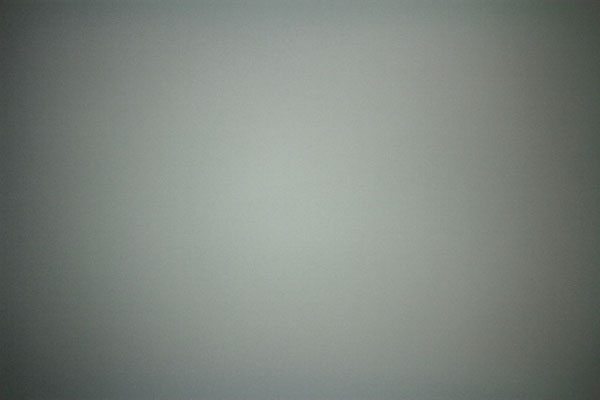
This one only shows edge darkening. You might also see blotches corresponding to
dust on the sensor. That's why flats are to useful — they correct for the
effect of that same dust in the actual picture.
Here (again stretched) is a flat field taken at 1/8000 second and showing shutter unevenness
or perhaps a strobe effect from high-frequency flicker of the light source:
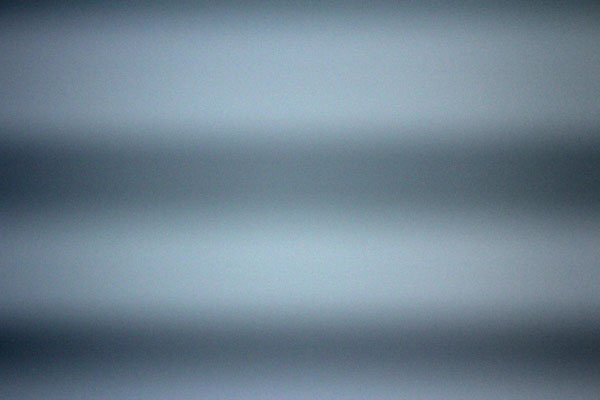
(No shutter should be expected to be perfectly even at its highest speed.
Remember, you're looking at tremendously stretched contrast.)
Permanent link to this entry


|
2013
October
7
(Extra)
|
Data-losing bug in Voice Record Pro 1.7 on iPhone 5 (iOS 7.0.2)
 (has bug) (has bug)
 (does not have bug) (does not have bug)
Some of my logs from the last two astrophotography sessions (October 1 and October 5)
were lost because of a bug in Voice Record Pro, which I was using to record my
notes on the iPhone.
The built in Voice Memos app does not have this problem, so it's what I'll use from now on.
If you pause a recording, and then put the iPhone to sleep, wake it up again,
and resume recording, Voice Record Pro will not actually add to the recording,
even though it appears to be recording properly.
Permanent link to this entry


|
2013
October
7
|
Bright and dark nebulae near Mu Cephei
To the lower left of center in the pictures below is Mu Cephei,
the "Garnet Star." Below it you see a large round nebula, a faint
cloud of glowing hydrogen. Elsewhere in the picture are dark nebulae
in front of star clouds. These nebulae are not very well known even
though they are often high in the North American sky.
|
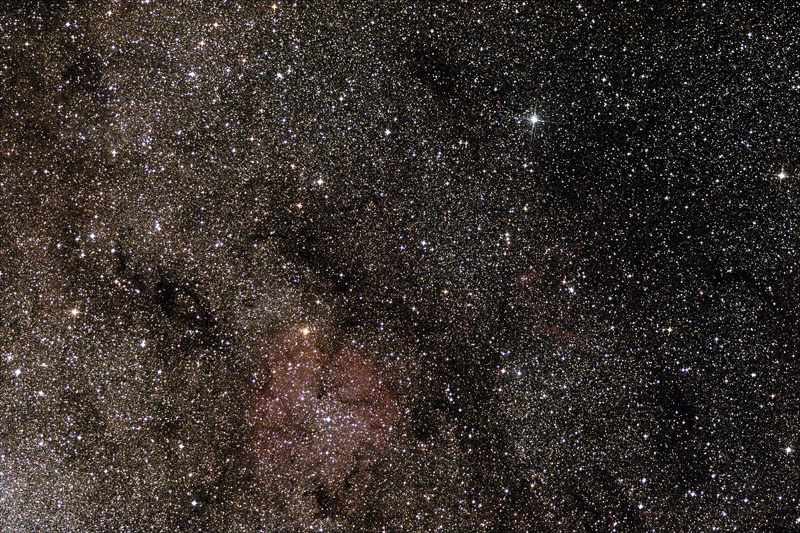
|
| |
[Reprocessed 2013 October 12.]
This is a stack of nine 30-second exposures at ISO 3200 with a Canon 60Da,
with a Sigma 105-mm f/2.8 lens wide open on an iOptron SkyTracker,
calibrated against dark frames, flats, and flat darks using
DeepSkyStacker.
Permanent link to this entry
My equipment on the field
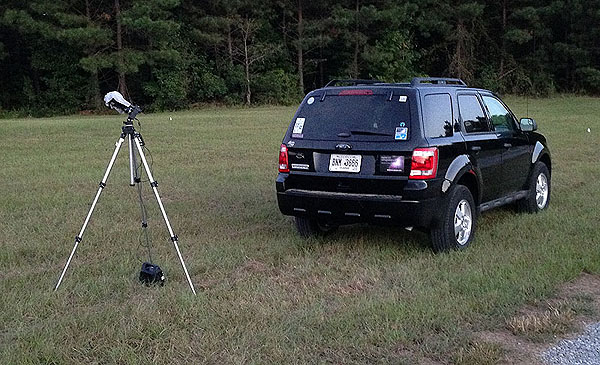
You may be wondering how much equipment I bring with me in order to
take pictures like this.
Here's what I took to the Peach State Star Gaze.
There's a gray piece of cloth over the camera to protect it from
dust and dew when it's not in use.
What you see here is a tripod, a battery, an
iOptron SkyTracker,
a camera
with a telephoto lens, and a
Kendrick dew heater
with a homebuilt controller of my own design (a 555 PWM circuit).
Permanent link to this entry


|
2013
October
3-6
|
Clouds of stars and clouds of dust
Here is one of the pictures I took at Deerlick on October 1.
You're looking at the star Altair, clouds of stars near the
center of our galaxy, and clouds of dust (dark nebulae) in
front of them. This is the same field I photographed from
in town last month.
The dark country sky helped!
|
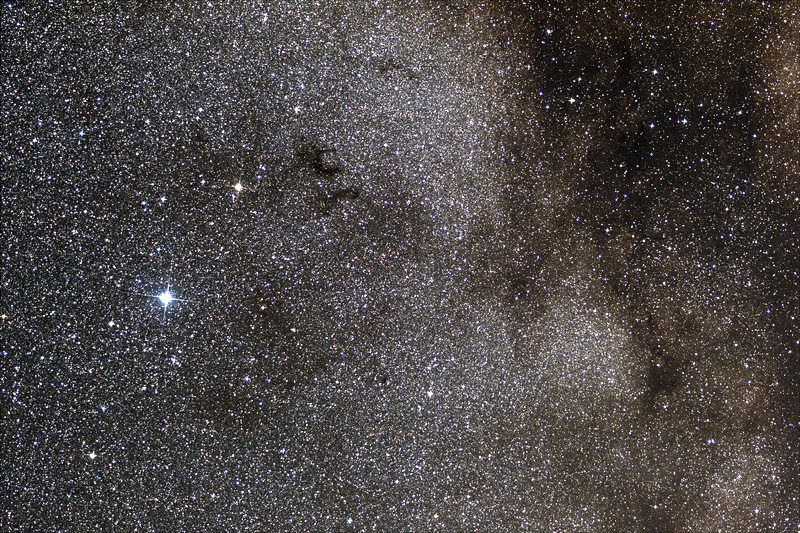
|
| |
[Reprocessed 2013 October 12.]
The most prominent dark nebulosity is called Barnard's E.
Stack of ten 30-second exposures at ISO 3200 with a Canon 60Da,
with a Sigma 105-mm f/2.8 lens wide open on an iOptron SkyTracker,
calibrated against dark frames, flats, and flat darks using
DeepSkyStacker.
Permanent link to this entry


|
2013
October
1-3
|
The sky is still there
On the evening of October 1, I had a successful trip to
Deerlick and took some very
good astrophotos, which you'll see here soon.
To put it in perspective, this was my first observing trip to Deerlick,
or indeed to any dark-sky site, since
November 2011 [corrected].
It's good to know the sky is still up there!
Also, I had a lot of new technology to play with.
I used my iPhone as a voice recorder (for the logbook), as a star atlas,
and for e-mail, Web surfing, and telephony.
Instead of a telescope, I carried the iOptron SkyTracker.
For that matter, this was actually the first time my Canon 60Da
had been to a dark-sky site!
And besides some digital work, I took my last Ektachrome astrophotos, using my
last roll of Ektachrome E100G, which is in a Canon EOS 10S camera body —
the one that can take long exposures without running down the battery;
the camera I should have had when I was spending money on a Nikon F3
system just before the demise of film.
That required some kluging. Dew was a problem, so I used masking tape to secure
the focusing ring of the lens, then wrapped a 3-inch Kendrick dew heater around it.
We'll see what happened... The last film astrophoto was a 25-minute exposure of
northern Cygnus, and I'll have it developed in a few weeks and post it here.
Permanent link to this entry
The opposite of progress is Congress...?
[Revised.]
If con is the opposite of pro, then the opposite
of progress is...
...the legislative body that is mismanaging our federal government and has
had the entire government shut down for three days, delaying the start of one
of my important (funded!) research projects.
If, as a UGA administrator, I had failed to submit a budget on time for anything
that I was in charge of, I would have been fired. Congress deserves no less.
I wish we had a British-style system where a deadlock in Congress would
automatically trigger an election.
I know Obamacare is bitterly controversial. If you were reading this blog
when it passed, you know that I also think it is seriously flawed and off-target.
But we don't know anything about it now that we didn't know six months ago.
Today's shutdown is a totally artificial emergency — not a response
to a sudden new development.
Whether Congress does its job properly is entirely separate from whether you're
for or against Obamacare.
There are calamities that might justify shutting down the normal functions of
government, such as, perhaps, preventing sudden entry into
an unjustified war. But blocking a piece
of legislation that Congress already passed, and that about half the American people
support, is not that kind of calamity. It is the job of Congress to
negotiate and pass a budget, on time, regardless of how divided the country may be.
Permanent link to this entry
People are trying to manipulate you with rumors
[Revised.]
And the rumor mill is starting up.
People are asking you and me to spread, on Facebook and other media, horror stories of how
badly Obamacare has treated someone — tens of thousands of dollars
for insurance — thousands in fines — hopelessness and despair —
but we don't know exactly who this happened to, or where, or when.
This morning's juicy story says that someone was hit with a heavy fine
by e-mail during the government shutdown. I think somebody might be making
things up.
Verify, ignore, or be made a fool of — those are your choices.
As you know, I am not a supporter of Obamacare; something needed to be done, but
not quite that. Nonetheless, Obamacare did pass, and it does address
some problems. One of the worst things about hoaxes and rumors is that
they divert attention from real, practical ways in which our health insurance system
could be improved.
Malicious gossip is a sore spot with me. I never engage in it myself, and
as some of you know, I tend to snap at people who try to involve me in it,
just the way I would snap at people trying to involve me in theft
or adultery. The last time I looked, "Thou shalt not bear false witness
against thy neighbor" was still one of the Ten Commandments.
It's wrong to spread rumors of unknown truthfulness even if they help your
favorite political cause. I know that, sometimes, an unproven political
allegation might be of legitimate national interest. But even then, you have a duty
to be honest about the evidence (and ignore the story if there is none),
not just swallow everything someone said.
Permanent link to this entry


|
|
|
This is a private web page,
not hosted or sponsored by the University of Georgia.
Copyright 2013 Michael A. Covington.
Caching by search engines is permitted.
To go to the latest entry every day, bookmark
http://www.covingtoninnovations.com/michael/blog/Default.asp
and if you get the previous month, tell your browser to refresh.
Entries are most often uploaded around 0000 UT on the date given, which is the previous
evening in the United States. When I'm busy, entries are generally shorter and are
uploaded as much as a whole day in advance.
Minor corrections are often uploaded the following day. If you see a minor error,
please look again a day later to see if it has been corrected.
In compliance with U.S. FTC guidelines,
I am glad to point out that unless explicitly
indicated, I do not receive substantial payments, free merchandise, or other remuneration
for reviewing or mentioning products on this web site.
Any remuneration valued at more than about $10 will always be mentioned here,
and in any case my writing about products and dealers is always truthful.
Reviewed
products are usually things I purchased for my own use, or occasionally items
lent to me briefly by manufacturers and described as such.
I am an Amazon Associate, and almost all of my links to Amazon.com pay me a commission
if you make a purchase. This of course does not determine which items I recommend, since
I can get a commission on anything they sell.
|
|























 (has bug)
(has bug)
 (does not have bug)
(does not have bug)


